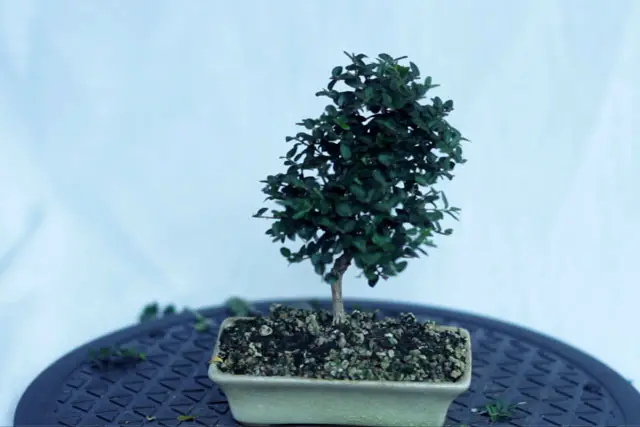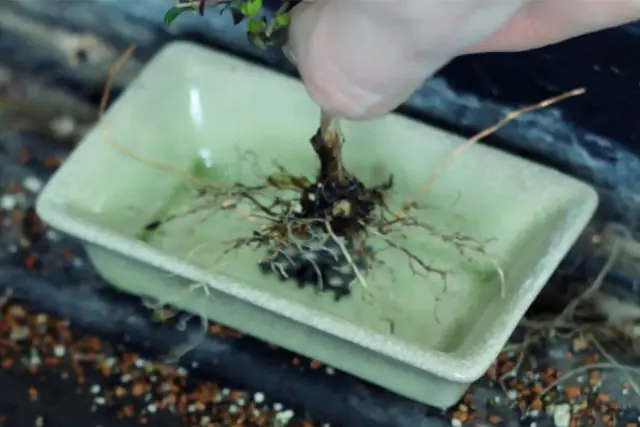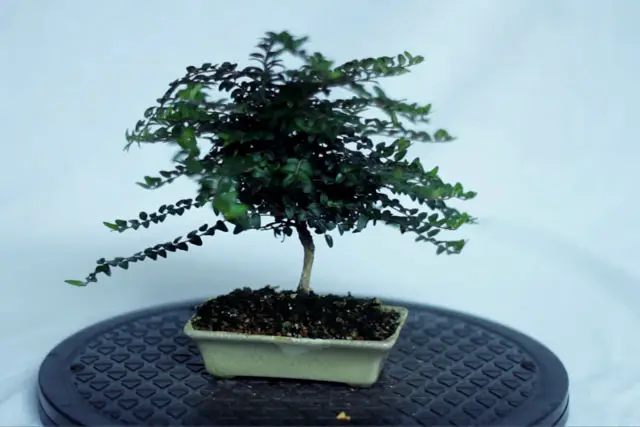There are a lot of different varieties of Lonicera but really only Lonicera Nitida and Lonicera Pileata are good for bonsai.
I have a Lonicera Nitida, it is a small broad leaf evergreen shrub. It is commonly used as hedging and topiary. It is part of the honeysuckle family and is often called “shrubby honeysuckle”. It has very small leaves and does not really look like your usual honeysuckle.
You can see the development of the tree that I started from a cutting in my Lonicera Bonsai Progression.

Page Contents
What Is The Natural Habitat of A Lonicera?
Lonicera Nitida is native to China but can now be found in garden hedgerows all the way across Europe.
There are a number of different varieties of Nitida. The main difference is the colour of the leaves. They can range from green to yellow and all sorts of variants in between.
What Soil Do Lonicera Bonsai Need?
Lonicera Nitida bonsai prefer a moist, well draining soil. I use my standard mix of equal parts Perlite/Molar Clay/Compost and I have not had any problems.
Lonicera is pretty tough and will grow in most conditions. Obviously if you are growing one as a bonsai you want to give them the best soil possible, which will a well draining soil, this will promote the best root growth and over all health.
(For more info on soil read – A General Guide To Bonsai Soil)
How Do You Water A Lonicera Bonsai?
As I just mentioned, Lonicera can grow in most conditions and will actually withstand a little drought, but they should be kept moist for best results.
You should water just before the pot dries out. The well draining soil will make sure that the pot is not waterlogged and it will help to keep the perfect level of moisture.
(For more info you can read –How To Water A Bonsai)
How Much Sun Light Does A Lonicera Bonsai Need?
Lonicera bonsai trees can take full sun. They can grow in less than ideal conditions, but you should aim to give yours as much sun as possible for best results.
You can grow them outside in full sun and this will be more than enough to keep them happy.
How Hardy Are Lonicera Bonsai?
Lonicera is fully hardy in the U.K. It can suffer frost damage at the tips, but the tree will regrow in the spring without any issues.
They can handle temperatures down to -15 °C/5 °F, which is pretty cold. Of course in a pot they can not go this low, but they should still survive below freezing without much issue.
If you weather is exceptionally cold and reaching down towards -15 °C/5 °F, especially for an extended period of time, I would consider protecting the tree to avoid damage. You should still keep it cold, just put in an unheated shed or somewhere equally as cold that will keep it safe from the most extreme temperatures.
(For more info you can read – Working Out How To Over Winter Bonsai Trees)
How Often Do You Feed A Lonicera Bonsai?
I feed my Lonicera bonsai once a month during the growing season with a general all purpose fertiliser which is more than enough to keep it healthy and growing strongly.
(For more info you can read – Do You Need To Use “Bonsai” Fertiliser?)
How Do Lonicera Bonsai Respond to Pruning?
Lonicera bonsai respond really well to pruning. They can become very dense very quickly, which is why they are very popular hedges and topiary. The tree will send out many shoots every time you prune it.
(For more info you can read- How To Prune A Bonsai Tree)
Repotting A Lonicera Bonsai
Lonicera bonsai should be repotted in spring. They are extremely hardy and could probably survive being repotted at any time, but of course it is best to wait until you see the spring buds starting to swell. Just because it can take a lot of abuse, doesn’t mean you need to push it to the limit.

Lonicera really like to grow roots and you can prune them quite hard and they will respond well to this. You will usually find the pot is full of roots when you go to repot.
(For more info you can read – How To Repot A Bonsai Tree)
Wiring A Lonicera Bonsai
Lonicera bonsai can be wired but you will find the best results come from pruning the foliage to shape.
Once the wood thickens, it can become hard to shape with wire, so it is best to put movement into younger branches, if possible.
(For more info read – Why Do We Wire Bonsai?)
What Is The Leaf Pattern Of A Lonicera Bonsai?
The leaves of Lonicera are very small oval shaped and are an opposites pattern on the branch.
What Pests Does A Lonicera Bonsai Suffer From?
Lonicera bonsai are generally pest free. If your tree is healthy and growing well it should not have any trouble from pests.
Can You Propagate A Lonicera Bonsai?
Lonicera root extremely easy from cuttings and air layers. You can literally cut a branch off and just shove it into some soil and it will root 99% of the time.

What Is The Growth Rate Of A Lonicera Bonsai?
Lonicera bonsai will grow very fast. It likes to send out long, straight and thin branches. These are not ideal, so you will need to prune the tree often to keep it in shape and promote more growth.
They need to put on significant length before they begin to thicken, which can make it difficult to develop a trunk for bonsai.
If you are trying to start a tree from a cutting it is going to take a very long time. You should really try and start with established material, such an old hedge. This will give you the best start for your lonicera bonsai. When you have material like this it is very easy to develop the foliage due to its fast growth rate.
Should You Get A Lonicera Bonsai?
Lonicera is a great tree for bonsai and beginners. They are very easy to care for as they are extremely tough and can handle anything you throw at it. It is a very aggressive grower and you will always be working on it, which is of course great for bonsai.
You can read more about why Lonicera Make Good Trees For Bonsai
If you can find one with an already established thick trunk, you will be able to great tree very quickly. They are a lot of fun and worth having in your collection.

Hi, I’m Ian. I have been doing bonsai since 2014. I created this site to spread all the knowledge I have acquired over the years. Don’t forget to check out my Youtube videos where I show the progress of my own Bonsai each week or connect with me on social media.
You can read more about me and how I got into Bonsai on the About Page


